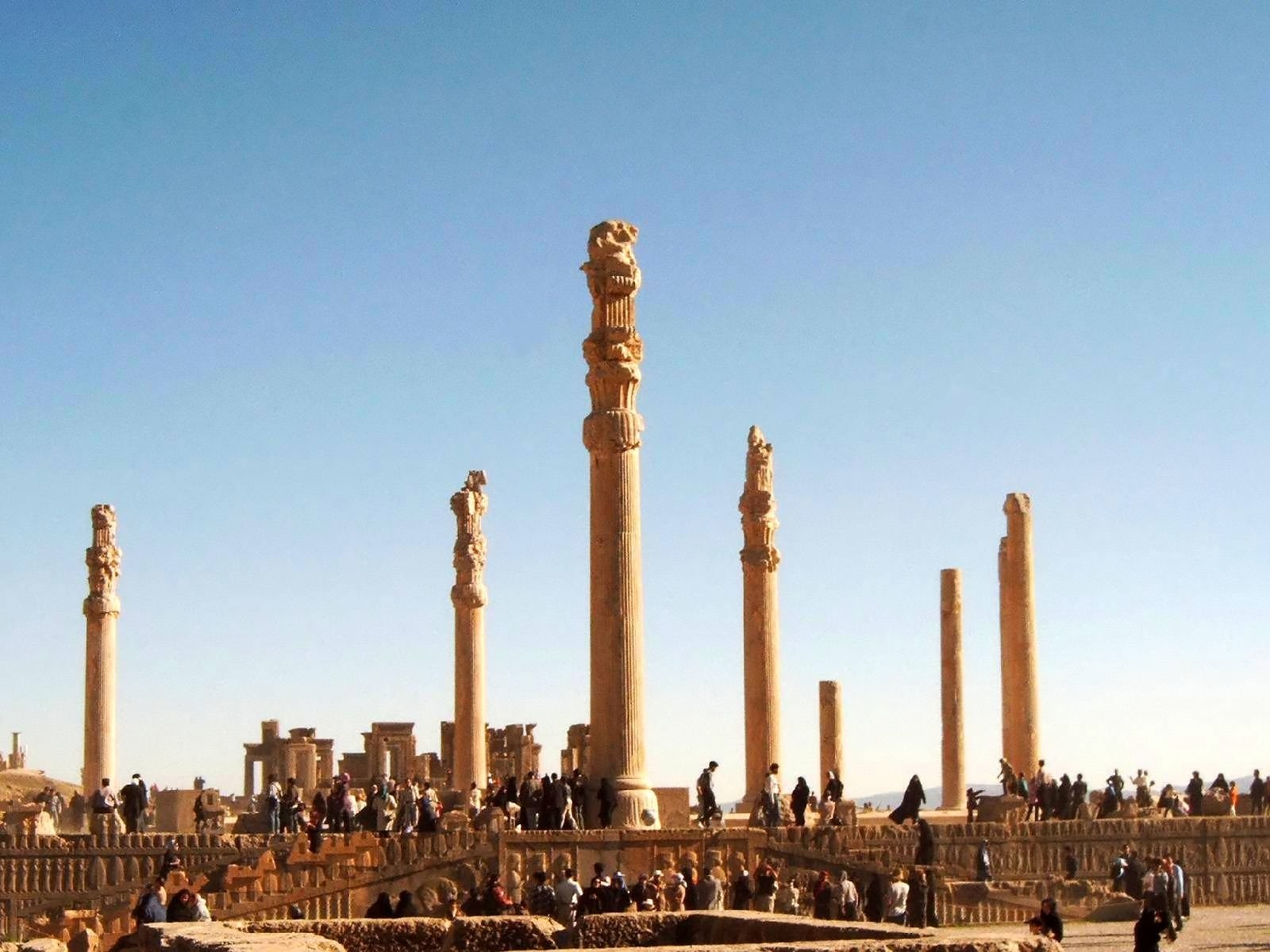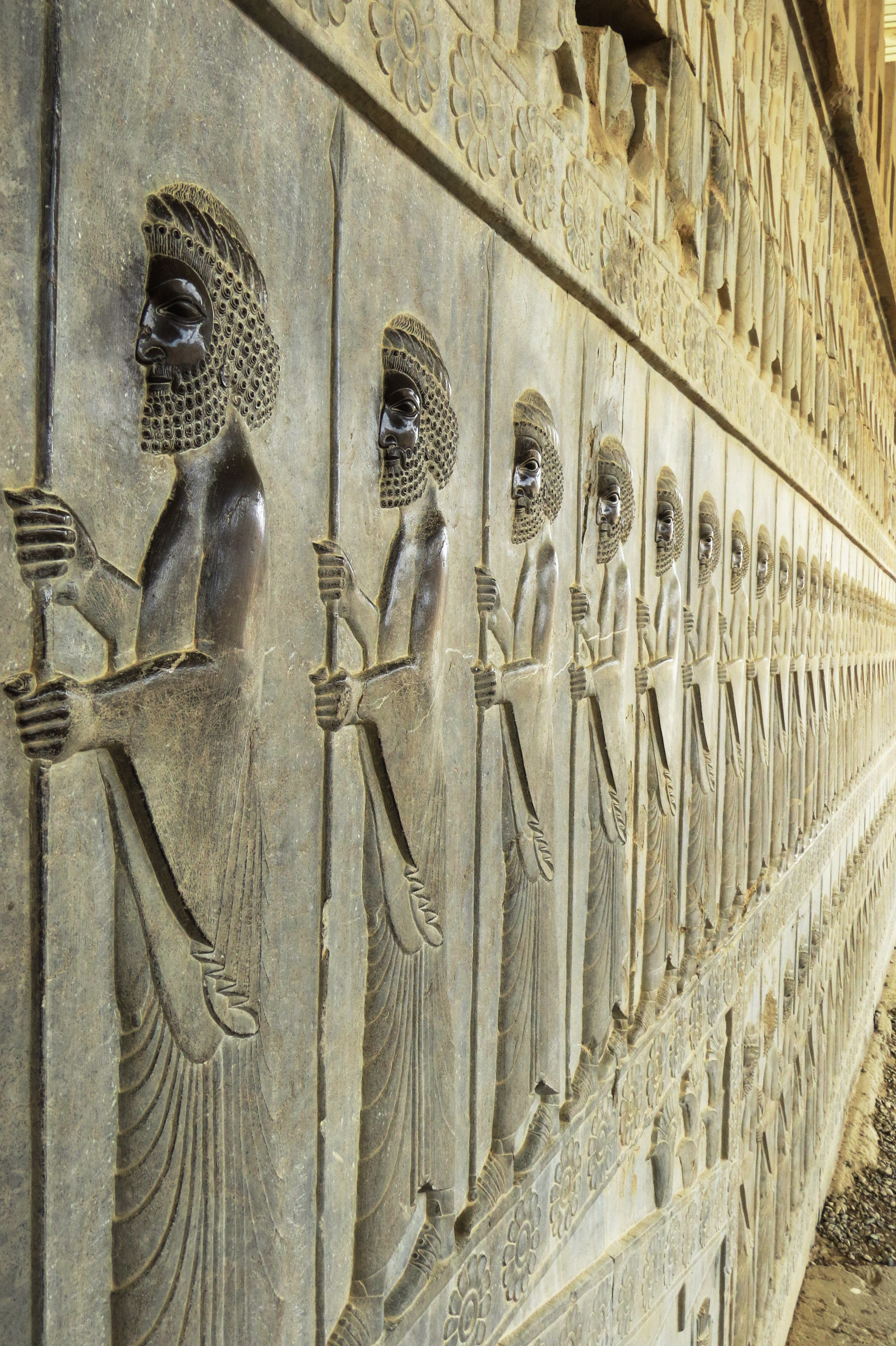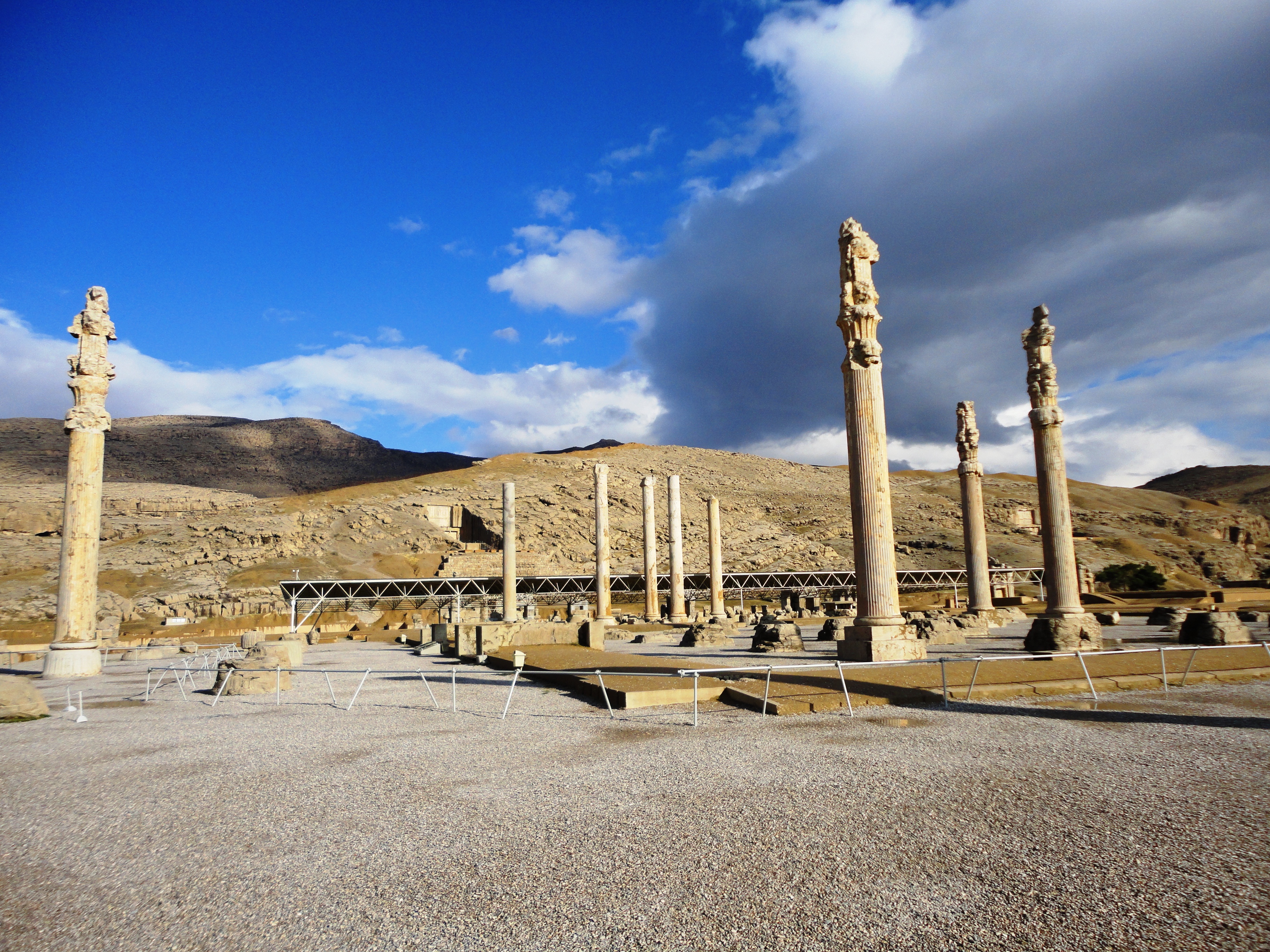Apadana palace persepolis.JPG on:
[Wikipedia]
[Google]
[Amazon]


 Apadana ( peo, 𐎠𐎱𐎭𐎠𐎴) is a large
Apadana ( peo, 𐎠𐎱𐎭𐎠𐎴) is a large

 The Apadana was the largest building on the Terrace at Persepolis and was excavated by the German archaeologist Ernst Herzfeld and his assistant Friedrich Krefter, and Erich Schmidt, between 1931 and 1939. Important material relevant to the excavations are today housed in the archives of the
The Apadana was the largest building on the Terrace at Persepolis and was excavated by the German archaeologist Ernst Herzfeld and his assistant Friedrich Krefter, and Erich Schmidt, between 1931 and 1939. Important material relevant to the excavations are today housed in the archives of the
Oriental Institute Photographic Archives
a virtual reconstruction of Apadana {{Fars Province Buildings and structures completed in the 5th century BC Achaemenid architecture Architecture of Iran Persepolis

 Apadana ( peo, 𐎠𐎱𐎭𐎠𐎴) is a large
Apadana ( peo, 𐎠𐎱𐎭𐎠𐎴) is a large hypostyle
In architecture, a hypostyle () hall has a roof which is supported by columns.
Etymology
The term ''hypostyle'' comes from the ancient Greek ὑπόστυλος ''hypóstȳlos'' meaning "under columns" (where ὑπό ''hypó'' means below or un ...
hall in Persepolis, Iran. It belongs to the oldest building phase of the city of Persepolis, in the first half of the 6th century BC, as part of the original design by Darius the Great
Darius I ( peo, 𐎭𐎠𐎼𐎹𐎺𐎢𐏁 ; grc-gre, Δαρεῖος ; – 486 BCE), commonly known as Darius the Great, was a Persian ruler who served as the third King of Kings of the Achaemenid Empire, reigning from 522 BCE until his d ...
. Its construction was completed by Xerxes I. Modern scholarship "demonstrates the metaphorical nature of the Apadana reliefs as idealised social orders". M. Root (1986) p. 1.
Etymology
As a word, (Old Persian
Old Persian is one of the two directly attested Old Iranian languages (the other being Avestan language, Avestan) and is the ancestor of Middle Persian (the language of Sasanian Empire). Like other Old Iranian languages, it was known to its native ...
𐎠𐎱𐎭𐎠𐎴, masc.) is used to designate a hypostyle hall, i.e., a palace or audience hall of stone construction with columns. The word is rendered in Elamite as ''ha-ha-da-na'' and in Babylonian ''ap-pa-da-an'' is etymologically ambiguous. It has been compared to the Sanskrit (आपादन) which means 'to arrive at', and also to the Sanskrit ''apa-dhā'' (अपधा) which means "a hide-out or concealment", and the Greek (), meaning "storehouse". The word survived into later periods in Iran, as the Parthian Parthian may be:
Historical
* A demonym "of Parthia", a region of north-eastern of Greater Iran
* Parthian Empire (247 BC – 224 AD)
* Parthian language, a now-extinct Middle Iranian language
* Parthian shot, an archery skill famously employed by ...
''Old Persian
Old Persian is one of the two directly attested Old Iranian languages (the other being Avestan language, Avestan) and is the ancestor of Middle Persian (the language of Sasanian Empire). Like other Old Iranian languages, it was known to its native ...
term 𐎠𐎱𐎭𐎠𐎴, ''a-pad-an'', standing for "unprotected", refers to the fact that the veranda-shaped structure is open to the outside elements on one of its four sides, and thus 'unprotected' / exposed to the natural elements. This is exactly what the Apadana palace has: open (columned) verandas on three sides—a unique feature among all palace buildings at Persepolis. The Parthian and Sasanian architects largely did away with the columns holding up the ceiling of the veranda, replacing them with a barrel vault
A barrel vault, also known as a tunnel vault, wagon vault or wagonhead vault, is an architectural element formed by the extrusion of a single curve (or pair of curves, in the case of a pointed barrel vault) along a given distance. The curves are ...
ing, such as the famous Ayvan of Kisra at Ctesiphon
Ctesiphon ( ; Middle Persian: 𐭲𐭩𐭮𐭯𐭥𐭭 ''tyspwn'' or ''tysfwn''; fa, تیسفون; grc-gre, Κτησιφῶν, ; syr, ܩܛܝܣܦܘܢThomas A. Carlson et al., “Ctesiphon — ܩܛܝܣܦܘܢ ” in The Syriac Gazetteer last modi ...
. The later evolution of term into aywan in the post-Islamic architecture that evolved from the old , refers to both columned (such as the palace of Chehel Sotoun, Isfahan
Isfahan ( fa, اصفهان, Esfahân ), from its Achaemenid empire, ancient designation ''Aspadana'' and, later, ''Spahan'' in Sassanian Empire, middle Persian, rendered in English as ''Ispahan'', is a major city in the Greater Isfahan Regio ...
) or barrel vaulted (all the four-aywaned mosques). Like the old Apadana, the new aywans are also verandas: open to the natural elements on one side.
As a modern architectural and archaeological term, the word ''apadana'' is also used to refer to Urartian
Urartian or Vannic is an extinct Hurro-Urartian language which was spoken by the inhabitants of the ancient kingdom of Urartu (''Biaini'' or ''Biainili'' in Urartian), which was centered on the region around Lake Van and had its capital, Tushpa, ...
hypostyle halls, such as those excavated at Altintepe and Erebuni. These halls predate those from Persia, and it has been proposed that Urartu could be the stylistic origin of the later Persian hypostyle audience halls.
Apadana Palace in Susa
The Apadana Palace inSusa
Susa ( ; Middle elx, 𒀸𒋗𒊺𒂗, translit=Šušen; Middle and Neo- elx, 𒋢𒋢𒌦, translit=Šušun; Neo-Elamite and Achaemenid elx, 𒀸𒋗𒐼𒀭, translit=Šušán; Achaemenid elx, 𒀸𒋗𒐼, translit=Šušá; fa, شوش ...
was built during the reign of Darius around 521 to 515 BC and by his order on the Elamite relics in Susa. The walls of this palace are made of clay with a brick facade and its columns are made of stone. Its inner walls were covered with glazed bricks and featured soldiers of the Eternal Guard, a winged lion, and a lotus flower.Important parts of the Apadana Palace caught fire during the reign of Artaxerxes I (461 BC) and were rebuilt during the reign of Artaxerxes II (359 BC).
Description

 The Apadana was the largest building on the Terrace at Persepolis and was excavated by the German archaeologist Ernst Herzfeld and his assistant Friedrich Krefter, and Erich Schmidt, between 1931 and 1939. Important material relevant to the excavations are today housed in the archives of the
The Apadana was the largest building on the Terrace at Persepolis and was excavated by the German archaeologist Ernst Herzfeld and his assistant Friedrich Krefter, and Erich Schmidt, between 1931 and 1939. Important material relevant to the excavations are today housed in the archives of the Freer Gallery of Art
The Freer Gallery of Art is an art museum of the Smithsonian Institution in Washington, D.C. focusing on Asian art. The Freer and the Arthur M. Sackler Gallery together form the National Museum of Asian Art in the United States. The Freer and Sac ...
in Washington, DC.
It was most likely the main hall of the kings. The columns reached 20m high and had complex capitals in the shape of bulls or lions. Here, the great king received the tribute from all the nations in the Achaemenid Empire and gave presents in return.
Access to the hall is given by two monumental stairways, on the north and on the east. These are decorated by reliefs, showing delegates of the 23 subject nations of the Persian Empire
The Achaemenid Empire or Achaemenian Empire (; peo, wikt:𐎧𐏁𐏂𐎶, 𐎧𐏁𐏂, , ), also called the First Persian Empire, was an History of Iran#Classical antiquity, ancient Iranian empire founded by Cyrus the Great in 550 BC. Bas ...
paying tribute to Darius I
Darius I ( peo, 𐎭𐎠𐎼𐎹𐎺𐎢𐏁 ; grc-gre, Δαρεῖος ; – 486 BCE), commonly known as Darius the Great, was a Persian ruler who served as the third King of Kings of the Achaemenid Empire, reigning from 522 BCE until his ...
, who is represented seated centrally. The various delegates are shown in great detail, giving insight into the costume and equipment of the various peoples of Persia in the 5th century BC. There are inscriptions in Old Persian
Old Persian is one of the two directly attested Old Iranian languages (the other being Avestan language, Avestan) and is the ancestor of Middle Persian (the language of Sasanian Empire). Like other Old Iranian languages, it was known to its native ...
and Elamite.
Measurements
The Apadana at Persepolis has a surface of 1000 square metres; its roof was supported by 72 columns, each 24 metres tall. The entire hall was destroyed in 331 BC by the army of Alexander the Great. Stones from the columns were used as building material for nearby settlements. By the start of the 20th century, only 13 of these giant columns were still standing. The re-erecting of a complete, but fallen column in the 1970s, is now the 14th standing column of the Apadana. The Apadana in Susa was—like the city itself—largely abandoned, and pillaged for building material.Legacy
The apadana hall influenced the Umayyad architecture. Early mosques built in Persia and Iraq imitate this structure.Notes
References
* *External links
Oriental Institute Photographic Archives
a virtual reconstruction of Apadana {{Fars Province Buildings and structures completed in the 5th century BC Achaemenid architecture Architecture of Iran Persepolis